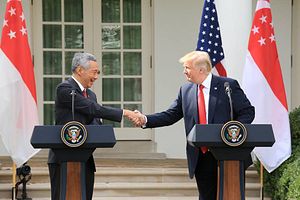Last week, the United States and Singapore concluded this year’s iteration of a key army exercise. The drills, which lasted from April 16 to April 24, were yet another illustration of the longstanding defense ties between the two sides and the importance of these interactions for the strengthening of the city-state’s defense capabilities given its own space constraints at home.
As I have written before, the United States and Singapore have long viewed each other as vital strategic partners, and that extends to the defense area as well. The United States is a key supplier of defense technology and facilities for military training for Singapore, while the city-state is a valuable regional partner across a range of issues from counterterrorism to maritime security, while also hosting a U.S. Navy logistics command unit that coordinates regional operations (“Strengthening the U.S.-Singapore Strategic Partnership”).
Despite some lingering uncertainties, collaboration in the defense domain has continued under U.S. President Donald Trump. Indeed, just earlier this month, the two sides had held the 9th iteration of their Strategic Security Policy Dialogue at the Pentagon in Washington, D.C., which, originally set up in 2006, is the highest level institutionalized security platform between both defense establishments.
One of the key components of the defense relationship is the series of exercises both sides undertake, which enhance the interoperability of their militaries for a range of purposes but also give Singapore’s military an opportunity to train overseas because of space constraints at home. There are a whole series of drills between the two sides, be it older, established ones such as Exercise Commando Sling, which is their longest-running air force exercise, or newer ones such as the new bilateral maritime exercise off of Guam called Exercise Pacific Griffin which saw its inaugural iteration take off last September (See: “What’s in the New US-Singapore Maritime Exercise in Guam?”).
One of these exercises is Lightning Strike, which was originally inaugurated back in 1996. Usually held annually in Singapore and the United States on a rotational basis, recent iterations of the exercise, which follows weeks of preparation and build-up training, have featured complex operational scenarios and interactions that see the integration of the two forces including in the operation of certain equipment.
From April 16 to 24, the United States and Singapore carried out the 11th iteration of Lightning Strike. The exercise, which was held at Joint Base Lewis-McChord in Washington, saw the participation of about 280 personnel from the 2nd Battalion of Singapore’s Infantry Regiment (2SIR) and the 4-23 Infantry Battalion from the U.S. Army.
According to Singapore’s defense ministry (MINDEF), during the exercise, both armies trained together to strengthen their interoperability in urban operations. The exercise saw a series of interactions, including soldiers from both armies operating in their U.S. Stryker Combat Vehicles, which culminated with an integrated battalion assault on an urban objective, with soldiers conducting Close Quarter Battle utilizing specialized urban operations equipment.
































